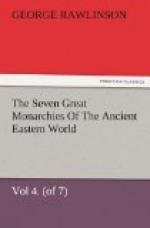The Religion of the later Babylonians differed in so few respects from that of the early Chaldaeans, their predecessors in the same country, that it will be unnecessary to detain the reader with many observations on the subject. The same gods were worshipped in the same temples and with the same rites—the same cosmogony was taught and held—the same symbols were objects of religious regard—even the very dress of the priests was maintained unaltered; and, could Urukh or Chedorlaomer have risen from the grave and revisited the shrines wherein they sacrificed fourteen centuries earlier, they would have found but little to distinguish the ceremonies of their own day from those in vogue under the successors of Nabopolassar. Some additional splendor in the buildings, the idols, and perhaps the offerings, some increased use of music as a part of the ceremonial, some advance of corruption with respect to priestly impostures and popular religious customs might probably have been noticed; but otherwise the religion of Nabonidus and Belshazzar was that of Urukh and Ilgi, alike in the objects and the mode of worship, in the theological notions entertained and the ceremonial observances taught and practised.
The identity of the gods worshipped during the entire period is sufficiently proved by the repair and restoration of the ancient temples under Nebuchadnezzar, and their re-dedication (as a general rule) to the same deities. It appears also from the names of the later kings and nobles, which embrace among their elements the old divine appellations. Still, together with this general uniformity, we seem to see a certain amount of fluctuation—a sort of fashion in the religion, whereby particular gods were at different times exalted to a higher rank in the Pantheon, and were sometimes even confounded with other deities commonly regarded as wholly distinct from them. Thus Nebuchadnezzar devoted himself in an especial way to Merodach, and not only assigned him titles of honor which implied his supremacy over all the remaining gods, but even identified him with the great Bel, the ancient tutelary god of the capital. Nabonidus, on the other hand, seems to have restored Bel to his old position, re-establishing the distinction between him and Merodach, and preferring to devote himself to the former.
A similar confusion occurs between the goddesses Beltis and Nana or Ishtar, though this is not peculiar to the later kingdom. It may perhaps be suspected from such instances of connection and quasi-convertibility, that an esoteric doctrine, known to the priests and communicated by them to the kings, taught the real identity of the several gods and goddesses, who may have been understood by the better instructed to represent, not distinct and separate beings, but the several phases of the Divine Nature. Ancient polytheism had, it may be surmised, to a great extent this origin, the various names and titles of the Supreme, which designated His different attributes or the different spheres of His operation, coming by degrees to be misunderstood, and to pass, first with the vulgar, and at last with all but the most enlightened, for the appellations of a number of gods.




